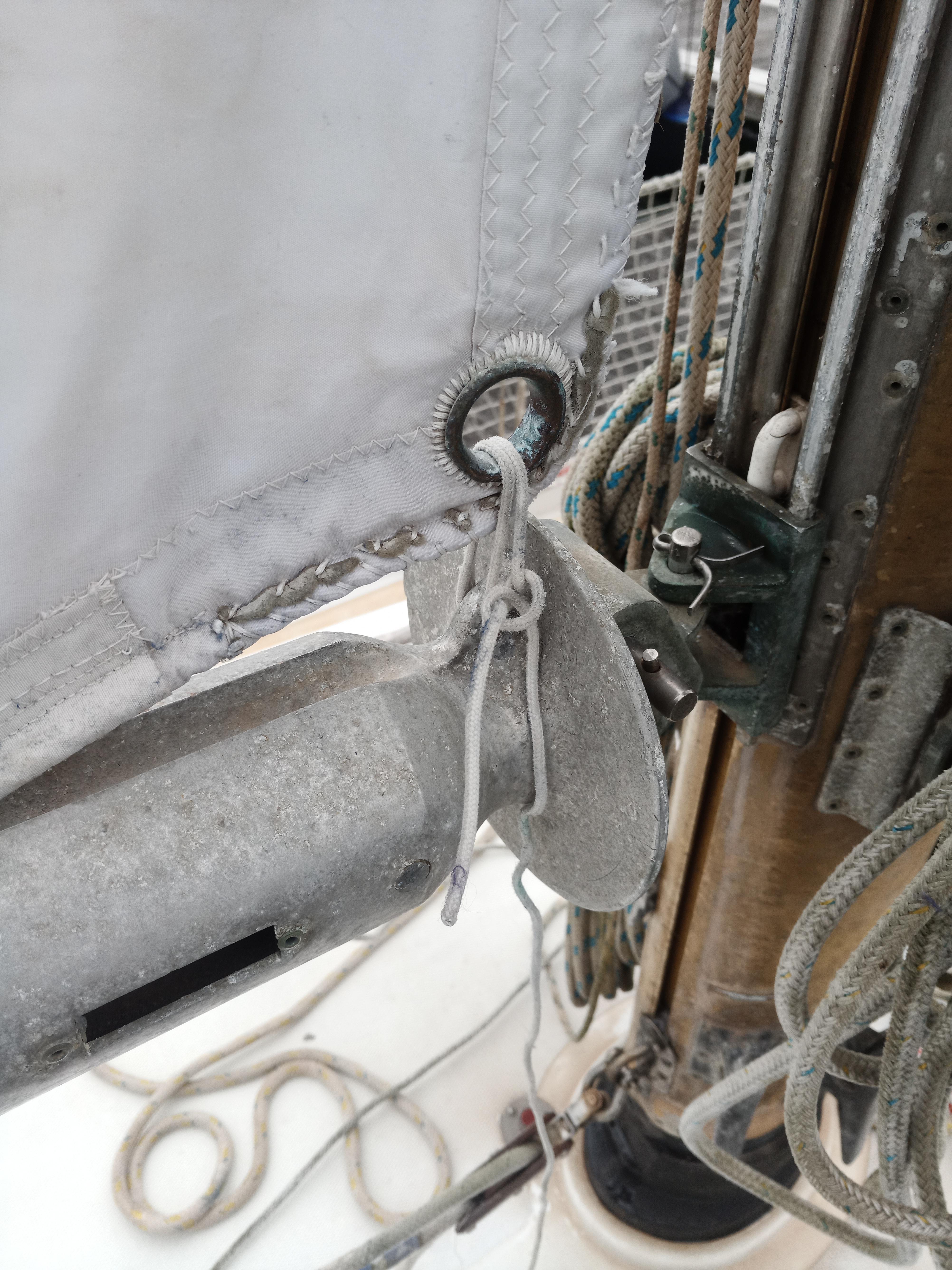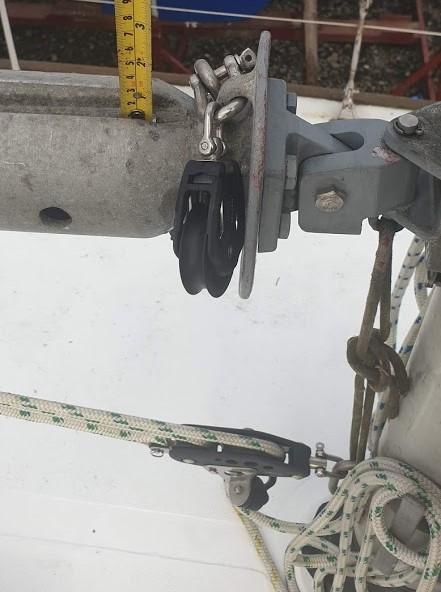Welcome Back › Forums › Rigging › Standing Rigging › Main Boom Gooseneck fittings? (and reefing question)
- This topic has 6 replies, 4 voices, and was last updated 3 years, 8 months ago by
 David and Felicity.
David and Felicity.
-
AuthorPosts
-
June 4, 2021 at 21:56 #26960
 Guy HParticipant
Guy HParticipantHi All – very new Nic38 owner here (and my first yacht ever!)
Below is a picture of my main boom gooseneck. It was stuck solid on the track & so low that the boom would not clear the cockpit roof.
After a lot of heat, boiling water, and some serious blows with a copper-faced mallet I managed to remove the fitting & now it slides freely
BUT, am I missing some bits here??
What holds the boom end down?
Should there be anything in the rectangular hole on the side of the boom?(I’ve replaced the cord with a shackle already)
Anything else anyone can spot that’s wrong?
It’s also got no provision for reefing either on the boom or the sail.
So I was going to fit a Barton kit and get the sail modified accordingly.
What should I do about the Tack end?Thanks for any help
 June 6, 2021 at 21:14 #26962
June 6, 2021 at 21:14 #26962Ken & Jan Cowan
ParticipantAs a partial response to what holds the boom end down, I have attached a pic of my boom. I have a bit of rope which restricts upward movement of the boom at the mast. I plan to replace this with a small locking block and tackle when I get to it.
 June 7, 2021 at 12:28 #26963
June 7, 2021 at 12:28 #26963 Guy HParticipant
Guy HParticipantThanks for your reply.
I could do it like that by getting something welded to the end of the SS pin however I am not sure I would want all that strain (of the luff tension) just on the split pin on the top.
I am wondering whether a direct connection to the sail tack (down to the kicker eye) might work?
June 10, 2021 at 01:41 #26969 VanParticipant
VanParticipantHi Guy, Welcome to the forum.
I’m glad to hear you could get the stuck gooseneck loose.
So my thoughts:
I can’t quite tell from your photo if your boom is still fitted with the roller reefing. Ken and Jan’s boom is not. Have a look at the first photo on this page: https://svrainshadow.com/?p=983 Just forward of the aluminum boom end where the sail tack is shackled, at the bottom of the black part you can see a hole that a winch bit fits into. That’s the roller furler. I guess this was trendy back in the 70s.
All sailmakers I talked to strongly advised against using the boom as a roller furler. So, we had a loose footed main made, which is slab reefed in the normal manner, using lazy jacks.
The tack is shackled to the hole on the top of the plate (like your photo after you replaced the cord). Along the luff of our sail are three cringles. The lowest cringle is about 12 inches above the gooseneck. I had the sail maker add that in case I needed to use the downhaul to tighten the luff. I rarely need it. The upper two cringles are for reefing.
So to answer your question: yes, a direct connection is possible, and you will want that ability anyway for reefing.
The downhaul is shown in Ken and Jan’s photo – it’s the vertical rope which they are correctly replacing with a block and tackle. Our has 3:1 purchase and is adequate. The top block is attached to a reefing hook, so I can stick it on any of the cringles. In fact, each cringle has a “dog bone” through it (a short piece of webbing with a ring at each end, on either side of the sail cringle. This makes it easier to attach the reefing hook (and I actually use a snap shackle not a reefing hook).
Regarding the force acting on the split pin, I do not think that the pin is the load bearing surface. If you look, the boom is resting upon the slider that fits into the mast. The clevis pin the is the hinge that allows horizontal movement, and is not load bearing in a vertical direction, only horizontal. So the split pin should not carry any load.
While we are talking about it, pay close attention to the hex head bolt just aft of the slider, that provides vertical freedom of motion. On our crossing from Seattle to Hilo, our crew discovered that the nut had worked its way off and the bolt was simply held in by luck and a bit of friction, and had already started working its way out. Scary! Crew got extra grog that night.
The rectangular hole on the starboard side is for the outhaul, which is internal to the boom. Check the link above for a full description of the outhaul.
Van
June 10, 2021 at 02:01 #26971 VanParticipant
VanParticipantOh, by the way, that rectangular slot in the boom can make the boom act like a flute as the wind freshes, and you get to hear this rather beautiful mournful whistling. As the wind speed and direction fluctuates, the pitch varies in a random manner. We like to call it the sound of the ghosts of drunken English sailors inhabiting our boat, and they often come out to sing when Rainshadow is flying into the wind on a starboard tack.
June 14, 2021 at 20:50 #26975 Guy HParticipant
Guy HParticipantI can’t quite tell from your photo if your boom is still fitted with the roller reefing. Ken and Jan’s boom is not. Have a look at the first photo on this page: https://svrainshadow.com/?p=983 Just forward of the aluminum boom end where the sail tack is shackled, at the bottom of the black part you can see a hole that a winch bit fits into. That’s the roller furler. I guess this was trendy back in the 70s.
No roller reefing & no slab reefing, I think before it was either up or down.
My setup is different though – external track rather than then the internal one and the old roller drive is that stainless shaft with the pin through it.
All sailmakers I talked to strongly advised against using the boom as a roller furler. So, we had a loose footed main made, which is slab reefed in the normal manner, using lazy jacks.
In the longer term I will get a new main made perhaps even full battened.
But for the moment I want to see if I can make the most of this sail for a year or so.
I am fitting lazy jacks and hopefully sewing up a stack pack as wellThe tack is shackled to the hole on the top of the plate (like your photo after you replaced the cord). Along the luff of our sail are three cringles. The lowest cringle is about 12 inches above the gooseneck. I had the sail maker add that in case I needed to use the downhaul to tighten the luff. I rarely need it. The upper two cringles are for reefing.
That makes sense, yes I understand all that
The downhaul is shown in Ken and Jan’s photo – it’s the vertical rope which they are correctly replacing with a block and tackle. Our has 3:1 purchase and is adequate. The top block is attached to a reefing hook, so I can stick it on any of the cringles. In fact, each cringle has a “dog bone” through it (a short piece of webbing with a ring at each end, on either side of the sail cringle. This makes it easier to attach the reefing hook (and I actually use a snap shackle not a reefing hook).
Yes, that was my thinking as that puts the downhaul load into the luff rather than the through the gooseneck
Regarding the force acting on the split pin, I do not think that the pin is the load bearing surface. If you look, the boom is resting upon the slider that fits into the mast. The clevis pin the is the hinge that allows horizontal movement, and is not load bearing in a vertical direction, only horizontal. So the split pin should not carry any load.
I thought the ‘ring’ to which the down haul was attached was an extension of the pin. I don’t have a fitting like that on my slider. But I’d prefer a cringle in the luff and use that.
While we are talking about it, pay close attention to the hex head bolt just aft of the slider, that provides vertical freedom of motion. On our crossing from Seattle to Hilo, our crew discovered that the nut had worked its way off and the bolt was simply held in by luck and a bit of friction, and had already started working its way out. Scary! Crew got extra grog that night.
I’ve got a completely different end on mine. No bolt, just a captive pin.
The rectangular hole on the starboard side is for the outhaul, which is internal to the boom. Check the link above for a full description of the outhaul.
My outhaul is wrong somehow – I have been looking at your article and can’t quite get my head round it. I’ve got an endoscope camera for my phone so I am going to have a poke around in there to see if I can see what might be missing.
Thanks for all your help 🙂
July 6, 2021 at 22:10 #26990 David and FelicityParticipant
David and FelicityParticipantGuy,
Van is right you should have a block and tackle under the boom to tension the luff once you have hoisted the sail. I believe it is called a cunningham. You can use it to change the sail shape: have it tight in strong winds and looser it in light airs.
A decent sailmaker should be able to adapt your sail for slab reefing. They will fit extra cringles in for the tack. We have three reefs on ours but I don’t think we have ever used the third one. We tend to drop the sail completely and run on mizzen and suitably furled genoa.
We replaced our lazy jacks with a home sewn sail pack. It is well worth the effort. It makes dropping the sails really easy.
David
-
AuthorPosts
- You must be logged in to reply to this topic.